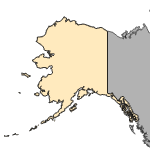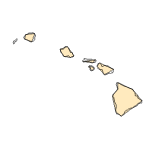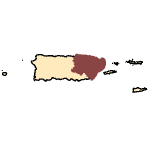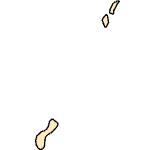Pomacea cumingii
(an applesnail)
Mollusks-Gastropods
Exotic |
|
Common name: an applesnail
Synonyms and Other Names: Ampullaria cumingii King & Broderip, 1831
Identification: A spherical shell, transversely fluted, greyish, chestnut lined and longitudinal stripes, green epidermis, short umbilicus [direct translation from Latin]: Reeve 1858: “Shell subglobosely ovate, rather solid, deeply umbilicated, spire short, whorls rather flat at upper part, then conxex, somewhat discoid; fulvous-ash [tawny], encircled with a few reddish narrow bands and lines; aperture ovate, effused, columellar lip rather thickened.”
Size: 34 mm height, 32.5 mm diameter, 24 mm aperture height (Morrison 1946)
Native Range: This species is native to Central America. The type locality is the island of Saboga, Pearl Islands, Panama in the Gulf of Panama (King 1835) where it is known only from this location (Thompson 2011). A type locality of the Island of Taboga, Panama has been used in error in the literature (eg. Reeve 1858 and Morrison 1946). Morrison (1952) corrected the error, most likely due to the similarity of the two island names. Although it is not found on the Isthmus of Panama (Morrison 1946), it has been stated as native in the Panama Canal area by Angehr (1999). Pomacea cumingii may also be native to Ecuador (Cousin 1887, Miller 1879 both as cited in Rodriguez et al. 2017). Williams et al. (2001) stated this species is native to northeastern South America although no region or country was given. More likely it would be native to northwestern South America, in countries in close proximity to Panama. It is not native to Brazil (Baker 1913).



|

Alaska |

Hawaii |

Puerto Rico &
Virgin Islands |

Guam Saipan |
Hydrologic Unit Codes (HUCs) Explained
Interactive maps: Point Distribution Maps
Nonindigenous Occurrences:
Table 1. States with nonindigenous occurrences, the earliest and latest observations in each state, and the tally and names of HUCs with observations†. Names and dates are hyperlinked to their relevant specimen records. The list of references for all nonindigenous occurrences of Pomacea cumingii are found here.
Table last updated 12/17/2025
† Populations may not be currently present.
Ecology: Freshwater streams.
Means of Introduction: For many years Pomacea cumingii was being imported to Puerto Rico for the aquarium fish industry; it was later replaced by suppliers with P. paludosa, a species native to Florida (Williams et al. 2001).
Status: The only North American collection of this species is from Puerto Rico and was made in 1954 from Loiza Reservoir (USNM 835005). It is believed to be established in Puerto Rico having reached densities of 10-30/m2 (Williams et al. 2001).
Impact of Introduction: Williams et al. (2001) state that the presence of P. cumingii in Puerto Rico may have displaced and replaced native mollusks. In general, the impact of applesnails as an agricultural pest, especially of rice crops, is well known (Joshi et al. 2017).
References: (click for full references)
Angehr, G.R. 1999. Rapid long-distance colonization of Lake Gatun, Panama, by snail kites. Wilson Bulletin 111(2):265-268.
Baker, F. 1913. The land and fresh-water mollusks of the Stanford Expedition to Brazil. Proceedings of the Academy of Natural Sciences of Philadelphia 65(3): 618-672.
Cousin, A. 1887. Faune malacologique de la République de l’Équateur. Bulletin de la Société Zoologique de France12: 187-287.*
Joshi R.C., Cowie R.H., and Sebastian L.S. (eds). 2017. Biology and management of invasive apple snails. Philippine Rice Research Institute (PhilRice), Maligaya, Science City of Muñoz, Nueva Ecija 3119.
King, P.P. 1835. Ampullaria cumingii. The Zoological Journal vol. 5 (July 1830-September 1831): 344. [Entire article number Art. XLVII pages 332 -349]
Miller, K. 1879. Die Binnenmollusken von Ecuador (Schluss.). Malakozoologische Blätter (Neue Folge) 1: 117-203.*
Morrison, J.P.E. 1946. The nonmarine mollusks of San Jose Island, with notes on those of Pedro Gonzalez Island, Pearl Islands, Panama. Smithsonian Miscellaneous Collections 106(6):1-49.
Morrison, J.P.E. 1952. Correction of the type locality of Pomacea cumingii. The Nautilus 65(3):105-106.
Reeve, L.A. 1858. Monograph of the genus Ampullaria: Species 81 Ampullaria Cumingii. Conchologia Iconica Vol. X
Rodriguez, M.C., E. Espinosa, and M.C. Rodriguez. Pomacea canaliculata in Ecuador: a recent pest with multiple implications. Pages 257-291 in Joshi R.C., Cowie R.H., and
Sebastian L.S. (eds). 2017. Biology and management of invasive apple snails. Philippine Rice Research Institute (PhilRice), Maligaya, Science City of Muñoz, Nueva Ecija 3119.
Thompson, F.G. 2011. An annotated checklist and bibliography of the land and freshwater snails of Mexico and Central America. Bulletin of the Florida Museum of Natural History 50(1):1-299.
Williams, E.H., Jr., L. Bunkley-Williams, C.G. Lilyestrom and E.A.R. Ortiz-Corps. 2001. A review of recent introductions of aquatic invertebrates in Puerto Rico and implications for the management of nonindigenous species. Caribbean Journal of Science 37(3-4):246-251.
*Not seen directly by author.
Author:
Benson, A.J.
Revision Date: 8/9/2019
Peer Review Date: 8/9/2019
Citation Information:
Benson, A.J., 2025, Pomacea cumingii (King & Broderip, 1831): U.S. Geological Survey, Nonindigenous Aquatic Species Database, Gainesville, FL, https://nas.er.usgs.gov/queries/FactSheet.aspx?SpeciesID=984, Revision Date: 8/9/2019, Peer Review Date: 8/9/2019, Access Date: 12/17/2025
This information is preliminary or provisional and is subject to revision. It is being provided to meet the need for timely best science. The information has not received final approval by the U.S. Geological Survey (USGS) and is provided on the condition that neither the USGS nor the U.S. Government shall be held liable for any damages resulting from the authorized or unauthorized use of the information.